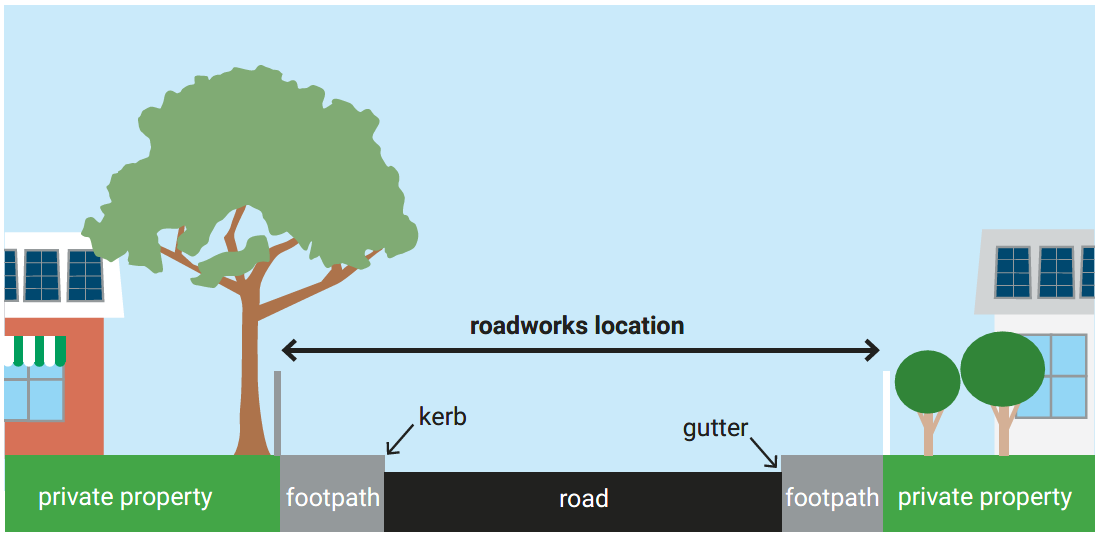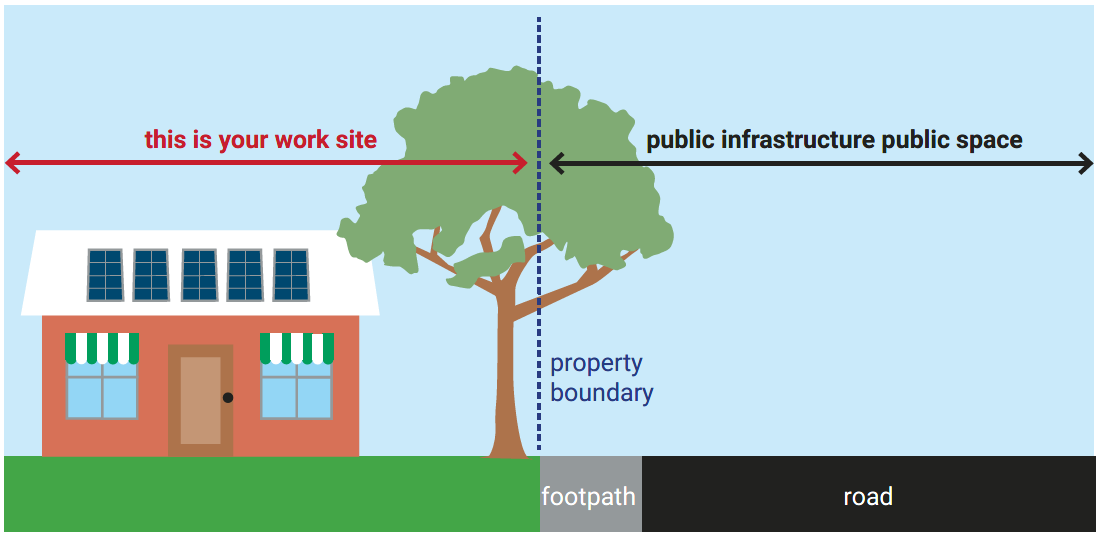Asset Protection Program

When you’re planning a new development, it’s essential to protect public infrastructure from damage. Damage to Council infrastructure, such as footpaths or kerbs, can create public safety risks and may result in financial costs for the landowner. If public infrastructure is damaged during your development, you must restore it to its original condition in line with Council standards.
The City of West Torrens runs an Asset Protection Program to help monitor Council infrastructure at development sites. As part of this program, Council officers conduct on-site inspections to check the condition of infrastructure before, during and after construction.
As the property owner, you are responsible for repairing any damage or non-compliance to Council assets. This includes footpaths, driveway crossovers, kerbs and gutters, and applies to any damage from demolition, building works, contractors or utility providers.
You must make sure everyone involved in your project understands these responsibilities. We recommend you discuss asset protection and reinstatement with your builder or contractors early in the process.
Council can recover the costs of road or footpath repairs—or require you to carry out this work—under the Local Government Act 1999.

What is public infrastructure?
The City of West Torrens is the owner of all public roads and associated infrastructure within its area, such as:
- footpaths
- kerb and water tables
- kerb ramps
- side entry pits
- signs
- spoon drains
- verges (including vegetation/trees).
What typically gets damaged?
Examples of typical damage include, but are not limited to:
- Cracked or broken footpaths and vehicle crossing panels.
- Chipped or broken kerb panels.
- Scraped or scoured bitumen seal.
- Damaged or removed street trees.
- Wheel marks and holes in the nature strip.
- Broken pits or cracked lids.
- Cutting channels made by various utility and service providers on instruction from the owner/builder during the development of the site (e.g. electrical, water, gas contractors, etc).
How damage can be caused
Damage to Council infrastructure can commonly be caused by:
- Using heavy machinery to cross from the road to the development site, which can easily damage kerbs and footpaths.
- Reinstating trenching works with the incorrect materials and not to standard. This can lead to sinking and tripping hazards after a period of time post-reinstatement.
- Old/redundant cross-over inverts not re-instated back to kerb.
- Rectification works not undertaken to standard and, as a result, the works fail.
Preventative measures
When building a new development, it's important to remember that public infrastructure must be protected against any potential damage. Good site management practices can minimise or eliminate damage to Council-owned assets creating a safer area for people working within the development site and users of public infrastructure.
There are actions that can be taken to minimise damage to Council infrastructure. Some of these include:
- Using existing entry and exit points when accessing site.
- Parking parallel to kerb to off-load materials.
- Installing a ramp at the kerb edge when an existing crossing place can’t be utilised. This will minimise contact with kerbing infrastructure.
- Using wooden slats that can be laid when traversing footpaths and removed when not in use.
When damage occurs
We strongly encourage the use of preventative techniques to minimise damage to Council infrastructure. However, when damage occurs, the damaged area must be made safe and maintained in a safe condition until final reinstatement, which must occur near the completion of development.
Council accepts these materials for temporary (make-safe) reinstatement:
- Cold-mix asphalt.
- Compacted gravel (if you use gravel, the area must always remain safe).
Please make sure the surface is flat and level with the surrounding footpath to prevent trip hazards.
Examples of acceptable make-safe methods can be found in the accompanying photographs.
Landowner/builder, what are your responsibilities?
As the developer of the property, you need to be aware of the following:
- Public infrastructure damaged during development activity must be reinstated to pre-development condition in accordance with Council standards. Council has power under the Local Government Act to recover costs to reinstate assets that have been damaged.
- Trenches created for underground service and stormwater connections must be reinstated.
- Council's Verge Management Policy stipulates that redundant vehicular crossing places (driveway and invert) must be removed and replaced with kerb and gutter that matches the existing structure, unless otherwise agreed by Council.
- All pedestrian walkways, footpaths, roadways and the area adjacent to or nearby the building site must be kept free of materials for pedestrian and traffic safety.
- The footpath and verge area must always be kept clear of obstructions including vehicles, building supplies or materials and debris. If keeping the area clear is not feasible, a hoarding permit is required.
- All building work and activities must be undertaken in a manner that will not pollute the environment or cause an environmental nuisance. Activities should not have an adverse effect on neighbouring properties (i.e. dust, noise, waste and odour).
- All building materials must be contained on site and must not be positioned where it is likely to enter the stormwater system during inclement weather.
- Drag out, such as mud, gravel, sand and concrete, onto the road must not occur as this material is likely to enter the stormwater system, which could lead to blockages and pollution.

Reinstatement timeframes
Developments granted from August 2024 onwards:
- All rectification works must be completed within six (6) weeks of handover of the site.
- For damages that pose a safety issue, reinstatement must occur within four (4) weeks.
- If works are not completed within the specified timeframe, Council will undertake the necessary works on your behalf and issue an invoice for the associated costs. Council has the authority, under the Local Government Act 1999, to recover costs for roadworks or to require roadworks to be undertaken.
Utility provider works and responsibilities FAQs
Who is responsible for reinstatement works that have been left by a utility provider?
The utility provider (e.g., SA Water, APA, SA Power Networks, NBN) engaged to conduct works is responsible for restoring the land to a condition similar to its condition before the activity began.
Restoration should begin within 10 business days after work is completed. For a more accurate timeframe, contact the relevant utility provider directly.
Major utility providers:
A utility provider removed a section of the Council-owned asset to access infrastructure but hasn’t reinstated it or has left the work site in poor condition. Who is responsible for following up?
Council officers often review land access notifications and engage directly with utility providers for works that may significantly affect our infrastructure. This includes conducting regular site visits. However, due to the volume of new infrastructure installations within West Torrens, it can be challenging to monitor every work site.
If you notice issues with works conducted by utility providers, you can help by:
- Contacting the provider directly (if known) and reporting the issue. You can also obtain updated information regarding the works.
- Contacting the council (if provider unknown) and providing us with the work location, how long the issue has been present, a photograph and any other information. We can then assist with background investigations to identify the party responsible.
Reinstatement by a utility provider is failing (e.g., trench sinking). Who is responsible for rectification?
The utility provider responsible for conducting the works is also accountable for rectifying any reinstatement that does not meet council standards.
Council officers regularly engage with providers to ensure adherence to these standards. If you notice a failure in reinstatement, you can report it to us or directly to the utility provider responsible.